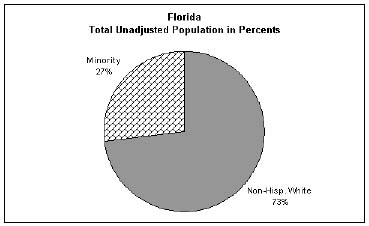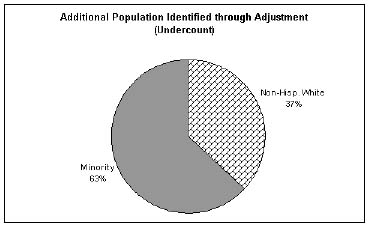State-by-State Analysis: Florida
The
1990 undercount and its demographic composition
As
indicated in Table 1, the percentage undercount of 2.0 percent in Florida
was higher than the national average of 1.6 percent and resulted in a net
numerical undercount of 259,829 persons, fourth highest in the nation. For
non-Hispanic whites, Table 1 indicates, the undercount percentage was only
1.0 percent as compared to 4.7 percent for members of minority groups, the
vast majority of whom were non-Hispanic blacks or Hispanics. As indicated
in Table 2 and the summary chart below, these differentials between whites
and minorities resulted in an undercounted population with a much greater
minority group percentage than the state's total population. Minorities
comprised 27 percent of the state's uncorrected population, compared to
63 percent of the state's undercounted population. In numerical terms, the
undercount consisted of 97,250 non-Hispanic whites and 162,579 members of
minority groups. The minority population of Florida consists primarily of
non-Hispanic blacks and Hispanics. According to corrected census data, non-Hispanic
blacks are 49 percent of Florida's minority population, Hispanics are 46
percent, and members of other minority groups are 5 percent.


Implications
of 1990 Census adjustment for minority voter opportunities
The
use of corrected data in Florida for the post-1990 redistricting would have
had the potential to enhance minority voter opportunities in the plans drawn
for the State Senate and State House. In the Florida State Senate, there
are no districts with minority percentages approaching 50 percent. However,
use of corrected data would have created the potential to enhance minority
voter opportunities by increasing the minority percentages of State Senate
District 38 in Dade County (43.0 percent minority). In Dade County, correction
uncovers some 74,000 persons, 93 percent of whom are members of minority
groups. These numbers are greater than would have been necessary to meet
one-person, one-vote requirements given that the use of corrected rather
than uncorrected data would increase the population of an ideal Senate district
from some 323,400 to 329,900 persons, a net increase of about 6,500 persons.
The
use of corrected rather than uncorrected Census data in Florida would have
had a similar impact on State House districts. In the Florida State House,
there are no districts with minority percentages approaching 50 percent.
However, use of corrected data would have created the potential to enhance
minority voter opportunities by increasing the minority percentages of State
House districts 105 (40.3 percent minority) and 119 (38.9 percent minority)
in Dade County. As indicated above, in Dade County, correction uncovers
some 74,000 persons, 93 percent of whom are members of minority groups.
These numbers are greater than would have been necessary to meet one-person,
one-vote requirements given that the use of corrected rather than uncorrected
data would increase the population of an ideal House district from some
108,000 to 110,000 persons, a net increase of about 2,000 persons.





